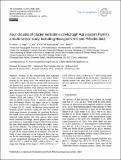Four decades of glacier variations at Muztagh Ata (eastern Pamir) : A multi-sensor study including Hexagon KH-9 and Pléiades data
Abstract
Previous in situ measurements have indicated a slight mass gain at Muztagh Ata in the eastern Pamir, contrary to the global trend. We extend these measurements both in space and time by using remote sensing data and present four decades of glacier variations in the entire mountain massif. Geodetic mass balances and area changes were determined at glacier scale from stereo satellite imagery and derived digital elevation models (DEMs). This includes Hexagon KH-9 (year 1973), ALOS-PRISM (2009), Pléiades (2013) and Landsat 7 ETMC data in conjunction with the SRTM-3 DEM (2000). In addition, surface velocities of Kekesayi Glacier, the largest glacier at Muztagh Ata, were derived from amplitude tracking of TerraSARX images (2011). Locally, we observed strong spatial and temporal glacier variations during the last four decades, which were, however, on average not significant for the entire massif. Some south-west-exposed glaciers fluctuated or advanced, while glaciers with other aspects rather experienced continuous shrinkage. Several glaciers such as Kekesayi indicate no measurable change at their frontal position, but clear down-wasting despite mostly thick debris coverage at low altitudes. The surface velocity of this debriscovered glacier reach up to 20 cm per day, but the lowest part of the tongue appears to be stagnant. The low velocity or even stagnancy at the tongue is likely one reason for the down-wasting. On average, the glaciers showed a small, insignificant shrinkage from 274.3 ± 10.6 km2 in 1973 to 272.7 ± 1.0 km2 in 2013 (-0.02 ± 0.1%a-1). Average mass changes in the range of -0.03 ± 0.33mw.e. a-1 (1973-2009) to -0.01 ± 0.30mw.e. a-1 (1973-2013) reveal nearly balanced budgets for the last 40 years. Indications of slightly positive rates after 1999 (+0.04 ± 0.27 mw.e. a-1) are not significant, but confirmed by measurements in the field.
Citation
Holzer , N , Vijay , S , Yao , T , Xu , B , Buchroithner , M & Bolch , T 2015 , ' Four decades of glacier variations at Muztagh Ata (eastern Pamir) : A multi-sensor study including Hexagon KH-9 and Pléiades data ' , The Cryosphere , vol. 9 , no. 6 , pp. 2071-2088 . https://doi.org/10.5194/tc-9-2071-2015
Publication
The Cryosphere
Status
Peer reviewed
ISSN
1994-0416Type
Journal article
Collections
Items in the St Andrews Research Repository are protected by copyright, with all rights reserved, unless otherwise indicated.

